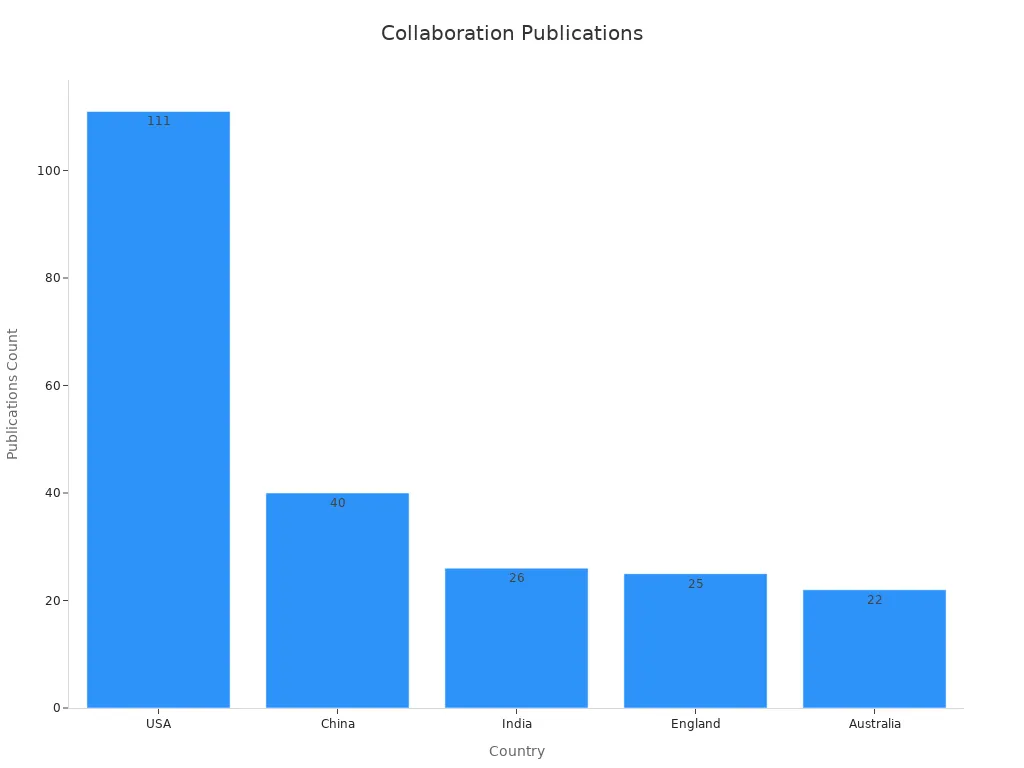How to Get Your Brand Mentioned in ChatGPT

Getting your brand mentioned in ChatGPT helps people notice it. Many trust AI like ChatGPT more than regular text, and this trust helps your brand get attention easily. To get mentioned, make clear and detailed content. Match your content with ChatGPT’s training topics. Good content increases your chances of being noticed.
Key Takeaways
Write simple and clear content to get noticed by ChatGPT.
Use E-E-A-T rules to make your content trustworthy and strong.
Apply SEO tips to help ChatGPT find and rank your brand.
Understanding ChatGPT Mentions
How ChatGPT Sources and Processes Information
To know how ChatGPT works, you must learn where it gets data. ChatGPT is trained using a huge collection of information. This includes websites like Wikipedia, books, news, and science journals. The goal is to cover many topics so it can answer different questions. But it’s not just about gathering data. The data is cleaned by removing repeats, fixing mistakes, and organizing it neatly. This helps the AI learn from good-quality content.
The model has 175 billion settings, helping it understand tricky language patterns. Instead of using tons of data, the focus is on quality. For example, GPT-3’s dataset was reduced to 570 GB from 45 TB. This shows that smaller, well-organized data works better than messy, large datasets.
The Role of Public Data in ChatGPT Search
Public data is key to how ChatGPT gives answers. It collects information from the internet, so your public content might be included. This is why making good, easy-to-read content matters. Tools like UTM codes help track how ChatGPT affects website visits. For example, ChatGPT citations often use UTM codes, but search results don’t. Knowing this difference helps you see how your content drives traffic.
Evidence Type | What It Does |
|---|---|
UTM Codes | Tracks where web traffic comes from, showing ChatGPT’s impact. |
Citations vs. Search | Citations use UTM codes, but search results don’t, changing traffic tracking. |
Tracking Value | Shows how useful ChatGPT-provided links are for your site. |
Why E-E-A-T-Compliant Content is Crucial for ChatGPT Mentions
To get noticed in ChatGPT, your content must follow E-E-A-T rules. E-E-A-T stands for Experience, Expertise, Authoritativeness, and Trustworthiness. Google likes content that meets these standards, and ChatGPT often does too. For example, AI-only content may not rank well without human input. Adding expert opinions and unique ideas makes your content stronger.
E-E-A-T is very important for topics like health or money. People trust content more when it’s written by someone with real experience. Also, interesting content keeps people on your site longer, which boosts visibility. By focusing on E-E-A-T, your content becomes helpful for both AI and readers.
Strategies to Get Mentioned in ChatGPT
Make Great Content with QuickCreator AI Blog Writer
To get noticed by ChatGPT, start with great content. Tools like QuickCreator AI Blog Writer make this simple and fast. This tool helps you create content that ranks high on search engines. Better rankings mean more people see your content, increasing chances ChatGPT will use it.
QuickCreator can make many blog posts quickly. Just type a keyword, and it creates interesting articles with updated facts and expert ideas. It also follows SEO rules, making it a strong tool for your marketing. With QuickCreator, you save time and grow your online presence.
Use AI-Friendly Formats to Optimize Content for ChatGPT
To get mentioned by ChatGPT, make your content AI-friendly. Focus on what your audience wants to know. Write clear answers to their questions. A friendly, conversational tone makes your content more engaging.
Structured data is very helpful. It helps ChatGPT understand your content better, improving its display in search results. Use different formats like videos, pictures, and text to keep readers interested. For example:
Metric Type | Description |
|---|---|
Visibility Boost | Structured data helps AI show your content better, making it more visible. |
Engagement Options | Using videos, pictures, and text keeps readers interested and meets different needs. |
User Signals | Clicks and time spent on pages show interest, helping your content rank higher. |
By following these tips, you can improve your chances of being mentioned and rank higher in searches.
Share on Public Platforms and Trusted Sources
Sharing on public platforms helps you get noticed by ChatGPT. Websites like Wikipedia, Reddit, and Quora are good places to start. When you share useful answers or ideas, more people see your content. Links to your site from these posts also show AI tools that your content is trustworthy.
For example, answering questions on Quora connects you with readers and increases your chances of being cited by ChatGPT. The more you share on public platforms, the more likely you’ll be mentioned. This builds trust and improves your online presence.
Gain Trust with Backlinks and Mentions
Trust is important for ChatGPT mentions. AI tools prefer websites with strong reputations. You can build this by getting backlinks from trusted websites. Backlinks improve your search rankings and make your brand more visible.
For instance, when trusted sites mention your brand, it shows AI tools that your content is reliable. This can lead to more mentions in ChatGPT answers. Backlinks also bring more visitors to your site and grow your brand awareness. Building trust helps your brand succeed over time.
Practical Steps to Boost ChatGPT Visibility
Use SEO Tips for AI Tools
To get your brand noticed by ChatGPT, focus on SEO. AI tools like ChatGPT need well-organized content to give good answers. Find out what keywords your audience searches for. Add these keywords naturally into your writing. Make sure your titles and headers are clear and catchy. Small changes like these can improve your content’s performance.
Here are some real-life examples of SEO success:
Jonathan Feniak, from LLC Attorney, said ChatGPT helped their firm get noticed in more states, increasing engagement.
A small online store in Germany used ChatGPT for content drafts. This cut costs by 30% and brought in more visitors.
A UK marketing agency used BrainChat.AI to improve SEO. This boosted their metrics and sped up projects.
These examples show how SEO can help you get noticed by ChatGPT. By using these tips, you can make your content easier for AI tools to find and increase user interest.
Work with Communities and Trusted Sites
Working with others can help your brand get noticed by ChatGPT. Join trusted communities or write for popular blogs to share your knowledge. Platforms like Reddit and Quora are great places to start. Sharing helpful ideas there can make your content more likely to be picked up by ChatGPT.
Here’s some data showing the power of collaboration:
Metric | Value |
|---|---|
Average co-authors per document | 3.31 |
Percentage of international collaborations | 24.62% |
Total countries participating | 59 |
USA publications | 33.234% (111) |
China publications | 11.976% (40) |
India publications | 7.784% (26) |
England publications | 7.784% (25) |
Australia publications | 6.587% (22) |
Collaborative linkages (USA) | 67 |
Collaborative linkages (China) | 32 |
Collaborative linkages (Switzerland) | 30 |

This data shows how working with others can grow your reach. Collaborating with trusted sources makes your content more visible and reliable.
Keep Content Updated for ChatGPT Search
Updating your content often is key to staying relevant in ChatGPT searches. AI tools like ChatGPT keep improving. For example, GPT-4 is 41% better than GPT-3.5 in a medical test. This shows why keeping your content current is so important.
Start by checking your old content regularly. Fix broken links and update outdated facts. Add new information to make your content more useful. Tools like QuickCreator AI Blog Writer can help you refresh articles quickly. This keeps your content engaging and optimized for SEO.
By updating your content, you show AI tools and readers that your brand is trustworthy. Staying consistent helps you get more mentions and better visibility over time.
Measuring the Impact of ChatGPT Mentions

Use Analytics Tools to Track ChatGPT Traffic
It’s important to see how ChatGPT brings visitors to your site. Tools like Google Analytics 4 (GA4) can help track this traffic. You can set up custom groups and filters to find ChatGPT referrals.
Here’s how traffic is sorted:
Self-referrals: Visits from the same site, like chatgpt.com to chatgpt.com.
Programmatic traffic: Visits with missing or special file types.
Redirect traffic: Visits from login pages or static files.
Tool-based traffic: Visits from browser add-ons or AI tools.
You can also group top websites by traffic manually. This helps you focus on actions that lead users to your site. By studying this data, you’ll understand how ChatGPT helps bring visitors to your platform.
Check Engagement and Conversions from ChatGPT Mentions
It’s key to know how users act after a ChatGPT mention. Test different parts of your content to improve results. For example, try two versions of a button to see which works better.
Steps to test and measure:
Pick something to test, like a headline or image.
Make two versions (A and B).
Split visitors evenly between the two options.
Track clicks, time spent, or other actions.
Compare results to find the better version.
Use the winner to improve conversions.
By testing and improving, you can guide users to take action. This boosts engagement and turns visitors into customers.
Use Feedback to Boost Future Visibility
Feedback helps improve your chances of being mentioned in ChatGPT. Look at both user comments and data. Feedback shows where your content can get better. Combine this with analytics to make smart updates.
For example, if users leave pages quickly, the content might not be interesting. Use tools like QuickCreator AI Blog Writer to update old articles or add new ideas. Regular updates show ChatGPT that your content stays useful, increasing mentions.
By listening to users and improving your strategy, you’ll make better content. This strengthens your brand and helps it appear more in ChatGPT searches.
Getting your brand noticed in ChatGPT needs effort and planning. Tools like QuickCreator AI Blog Writer make writing easier and improve SEO. Create fun and useful content to grab attention. Use automation to handle boring tasks and save time. Begin now, and see your brand appear more in AI answers!
FAQ
How does QuickCreator AI Blog Writer help with ChatGPT mentions?
QuickCreator makes content that’s SEO-friendly and easy for AI. It uses up-to-date facts and expert ideas to boost your brand’s visibility.
Can QuickCreator create content in different languages?
Yes! QuickCreator works in 28+ languages. You can make content for people worldwide, increasing your chances of being noticed by ChatGPT.
Will QuickCreator articles pass AI detection tools?
Yes! QuickCreator creates natural, human-like content. It follows E-E-A-T rules, so it easily passes AI detection checks.
See Also
Proven Blogging Techniques to Enhance Startup Growth And Visibility
A Comprehensive Guide to Defining Your Startup's Audience
Customizing Blog Posts to Satisfy Your Startup's Audience

